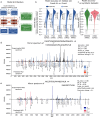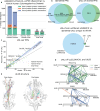Prosit-XL: enhanced cross-linked peptide identification by fragment intensity prediction to study protein interactions and structures
- PMID: 40592844
- PMCID: PMC12214610
- DOI: 10.1038/s41467-025-61203-4
Prosit-XL: enhanced cross-linked peptide identification by fragment intensity prediction to study protein interactions and structures
Abstract
It has been shown that integrating peptide property predictions such as fragment intensity into the scoring process of peptide spectrum match can greatly increase the number of confidently identified peptides compared to using traditional scoring methods. Here, we introduce Prosit-XL, a robust and accurate fragment intensity predictor covering the cleavable (DSSO/DSBU) and non-cleavable cross-linkers (DSS/BS3), achieving high accuracy on various holdout sets with consistent performance on external datasets without fine-tuning. Due to the complex nature of false positives in XL-MS, an approach to data-driven rescoring was developed that benefits from Prosit-XL's predictions while limiting the overestimation of the false discovery rate (FDR). After validating this approach using two ground truth datasets consisting of synthetic peptides and proteins, we applied Prosit-XL on a proteome-scale dataset, demonstrating an up to ~3.4-fold improvement in PPI discovery compared to classic approaches. Finally, Prosit-XL was used to increase the coverage and depth of a spatially resolved interactome map of intact human cytomegalovirus virions, leading to the discovery of previously unobserved interactions between human and cytomegalovirus proteins.
© 2025. The Author(s).
Conflict of interest statement
Competing interests: M.W. is a founder and shareholder of MSAID GmbH with no operational role and member of the scientific advisory board of Momentum Biotechnologies. The remaining authors declare no competing interests.
Figures





Similar articles
-
Cost-effectiveness of using prognostic information to select women with breast cancer for adjuvant systemic therapy.Health Technol Assess. 2006 Sep;10(34):iii-iv, ix-xi, 1-204. doi: 10.3310/hta10340. Health Technol Assess. 2006. PMID: 16959170
-
Prediction, screening and characterization of novel bioactive tetrapeptide matrikines for skin rejuvenation.Br J Dermatol. 2024 Jun 20;191(1):92-106. doi: 10.1093/bjd/ljae061. Br J Dermatol. 2024. PMID: 38375775
-
Signs and symptoms to determine if a patient presenting in primary care or hospital outpatient settings has COVID-19.Cochrane Database Syst Rev. 2022 May 20;5(5):CD013665. doi: 10.1002/14651858.CD013665.pub3. Cochrane Database Syst Rev. 2022. PMID: 35593186 Free PMC article.
-
Non-invasive diagnostic tests for Helicobacter pylori infection.Cochrane Database Syst Rev. 2018 Mar 15;3(3):CD012080. doi: 10.1002/14651858.CD012080.pub2. Cochrane Database Syst Rev. 2018. PMID: 29543326 Free PMC article.
-
Magnetic resonance perfusion for differentiating low-grade from high-grade gliomas at first presentation.Cochrane Database Syst Rev. 2018 Jan 22;1(1):CD011551. doi: 10.1002/14651858.CD011551.pub2. Cochrane Database Syst Rev. 2018. PMID: 29357120 Free PMC article.
References
-
- O’Reilly, F. J. & Rappsilber, J. Cross-linking mass spectrometry: methods and applications in structural, molecular and systems biology. Nat. Struct. Mol. Biol.25, 1000–1008 (2018). - PubMed
-
- Walzthoeni, T. et al. False discovery rate estimation for cross-linked peptides identified by mass spectrometry. Nat. Methods9, 901–903 (2012). - PubMed
MeSH terms
Substances
LinkOut - more resources
Full Text Sources

